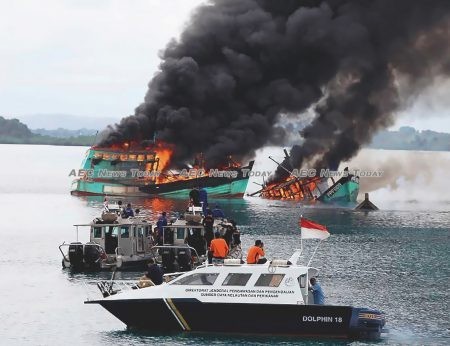China’s seemingly unstoppable expansion through the South China Sea finally hit a wall last week, an unyielding, uncompromising wall named Indonesia.

Unlike in the Philippines where Chinese fishing and coast guard vessels seemingly have almost free reign to plunder as much Philippines sea produce as they can harvest, Beijing’s attempt to steal fish from Indonesian waters hasn’t ended as successfully.
Maritime tension between the two countries most recently boiled over last week following the intrusion into Indonesia’s exclusive economic zone (EEZ) for a second time by Chinese fishing and coast guard vessels.
In dramatic video footage shot from the bridge of an Indonesian Navy ship, the Chinese coast guard ship is ordered to leave Indonesian waters “immediately”.
The confrontation followed a similar one late last month when more than 60 Chinese coast guard and fishing boats trespassed into Indonesia’s 200-nautical mile Exclusive Economic Zone (EEZ) near Natuna island. At the time the Chinese Ambassador in Jakarta was rapidly summoned by the Indonesian Foreign Ministry and issued a stern protest.
Swarming a Chinese technique

While China does not directly claim Natuna island as part of its esoteric nine-dash line, it does attempt to claim waters close by.
Swarming areas with a large number of fishing boats protected by coast guard ships is a technique China has used around Pag-asa Island, the Philippines, to withhold access to maritime resources from local fishers there (See: Balikatan 2019: US-Philippine troops hone battle skills as Chinese boats swarm (video)).
Leaving no question as to who Natuna Regency and the waters around it belong, President Joko Widodo flew to Natuna Besar, the regency’s main island, on Wednesday (Jan 8) as Indonesia’s largest military deployment in the Natuna islands to date unrolled.
With Indonesian Airforce fighter jets patrolling overhead and four Indonesian warships enroute to join four others already on-station, President Widodo told accompanying media: “We have a district here, a regent, and a governor here. There are no more debates. De facto, de jure, Natuna is Indonesia.”
Indonesia to create its own swarm
Taking a leaf from Beijing’s play-book Mr Widodo called on Indonesian fishers to register to fish in the Natuna Sea, with more than 120 from the northern coast of Java alone reportedly taking up the call.
Doubling-down, on Friday Mr Widodo reportedly used a visit to Jakarta by Japanese Foreign Minister, Toshimitsu Motegi, to ask Japan to ramp up its investment in fisheries and energy in the Natuna islands.
Last year Japan gave Indonesia IDR100 billion (about US$7.26mln) to build a fish market in Natuna, which will be named Tsukiji after the famous Tokyo fish market of the same name.

The unusual resistance seems to have caught China off-guard, with Indonesia’s Joint Defense Area Command I reporting late Thursday afternoon (Jan 9) that the Chinese vessels were leaving the area.
“The Chinese fishing vessels are gone, they are leaving the area heading north”, vice admiral Yudo Margono, said in Jakarta, adding that the Chinese vessels “were heading to Malaysia … They were heading straight”.
While the withdrawal of the Chinese vessels is a victory for Indonesia, it comes at a cost. Navy and air force assets have been diverted from other duties.
“There are normally three ships here and there are currently seven”, vice Admiral Margono said on Thursday, adding that a decision on the military build-up will be made after additional information is received.
Zero tolerance to fish thieves
Indonesia’s rapid military response is hardly surprising. The country has a well-deserved reputation for showing zero tolerance to those who trespass its waters to steal its fish, jailing boat captains and blowing up impounded vessels (See: Watch: Indonesia blows up pirate fishing boats after navy ship rammed (video))

Ranked 16 out of 137 countries in Global Firepower’s 2019 Military Strength Ranking, down from 10 last year, Indonesia is considerably outmatched by China, which ranks number three globally, and who launched 28 new warships alone in 2019.
Following a number of encounters with Chinese ships in Indonesian waters in 2016, including one in which the Indonesian Navy fired warning shots at Chinese-flagged vessels, Indonesia in 2017 renamed its EEZ north of Natuna island as the North Natuna Sea.
Further angering Beijing at the time, Indonesia’s Ministry of Foreign Affairs reiterated ‘that Indonesia does not have overlapping jurisdictions with China and that it never recognises the so-called nine-dash line’.
A five-point plan for developing the Natunas, includes new military facilities, fisheries, tourism, oil and gas, as well as preservation of the environment, was also rolled out and in 2018 Indonesia began building a military base on Natuna Besar.
The base will reportedly house several branches of the armed forces when complete, as well submarines, warships and fighter jets.
Under the leadership of Susi Pudjiastuti, Indonesia’s Ministry of Marine Affairs and Fisheries sank more than 550 boats caught illegally fishing in Indonesian waters over a five-year period.
How China reacts to its rejected folklore of the Natuna waters being traditional fishing grounds is yet to be seen, but clearly Indonesia is no Philippines when it comes to protecting its sovereignty.
Feature video WION
Related:
- Indonesia rejects China’s claims over South China Sea (Reuters)
- Indonesia boosts patrols after Chinese boat ‘trespasses’ in its waters (The Straits Times)
- China playing with fire over claim on Natuna waters (The Jakarta Post)
Stella-maris Ewudolu
Between November 2010 and February 2012 she was a staff writer at Daylight Online, Nigeria writing on health, fashion, and relationships. From 2010 – 2017 she worked as a freelance screen writer for ‘Nollywood’, Nigeria.
She joined AEC News Today in December 2016.
Latest posts by Stella-maris Ewudolu (see all)
- Zoonotic crossover fear sees Vietnam ban (almost) all wildlife trade (video) – July 26, 2020
- Job & revenue losses: COVID-19 to hurt Asean airlines the most – July 24, 2020
- Philippines morning news for July 24 – July 24, 2020
- Philippines morning news for July 23 – July 23, 2020

